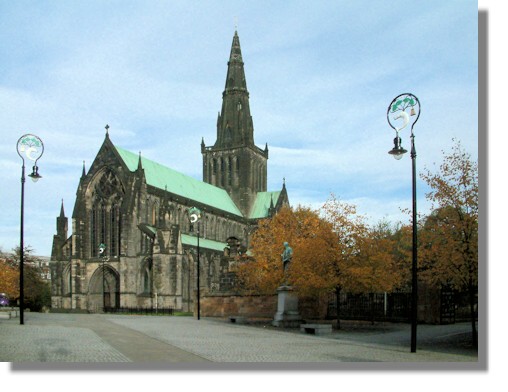

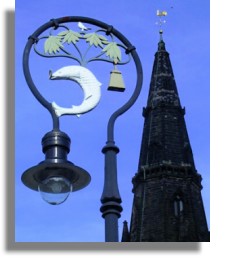
Legend says that St Mungo came to bury a monk at a cemetery dedicated to St Ninian, on the banks of the Molendinar Burn, a tributary of the river Clyde. Saint Mungo later became patron saint of Glasgow and a church, associated with him, was established beside the cemetery and became the centre of Glasgow which grew up around it. St Mungo was also known as St Kentigern (pictured on the left) and stories about the saint involving the saint became the emblems of the city (incorporated at the top of the lamp standards outside the cathedral (see graphic on the right)
There's the tree that never grew,
There's the bird that never flew,
There's the fish that never swam,
There's the bell that never rang.
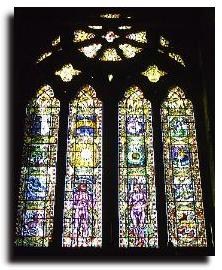
The cathedral was consecrated in 1136 in the presence of King David I. But this building was destroyed by fire and the present building was started in 1197 by Bishop Jocelyn and this was largely completed by the end of the 13th century. The "Glasgow Fair" which is still celebrated to this day, was started by Bishop Jocelyn. The cathedral was expanded and reconstructed in the 15th century. At the Reformation of the church, many ecclesiastical buildings were destroyed in Scotland but Glasgow Cathedral survived, partly because it was capable of being shared by the different congregations!
 The cathedral is 285 feet long and the open timber roof dates from the 14th century. The cathedral contains the regimental colours of a number of units, including the Highland Light Infantry (which was closely associated with Glasgow), the Scots Guards and the Cameronians. The Cathedral has magnificent stained glass windows, one illustrating the creation and others with the badges of the twelve Scottish regiments that fought in the Second World War.
The cathedral is 285 feet long and the open timber roof dates from the 14th century. The cathedral contains the regimental colours of a number of units, including the Highland Light Infantry (which was closely associated with Glasgow), the Scots Guards and the Cameronians. The Cathedral has magnificent stained glass windows, one illustrating the creation and others with the badges of the twelve Scottish regiments that fought in the Second World War.
A flight of stairs takes visitors to a "Lower Church" where some of the early 12th century stonework is still visible. The tomb of St Mungo is also located here and there are fragments of an old 13th century shrine to the Saint.
Also below the level of the main cathedral is the Blackader Aisle, built in the 15th century but said to occupy the site of the 5th century burial ground consecrated by St Ninian.
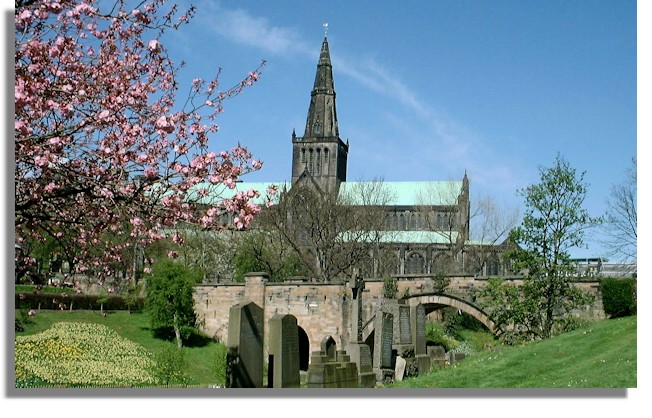
Fine views of the Cathedral can be obtained from the nearby Necropolis - an old burial ground on a hill which is now reached from the Cathedral by the "Bridge of Sighs". The characteristic square steeple which is such a feature of the building, was erected in the 15th century.
A relatively "recent" addition is the statue of the explorer and missionary, Rev David Livingston - see graphic below and Places to Visit in Scotland - David Livingstone Centre, Blantyre. Across the square from the cathedral is the St Mungo Museum of Religious Life and Art which covers all the main religions, not just Christianity.
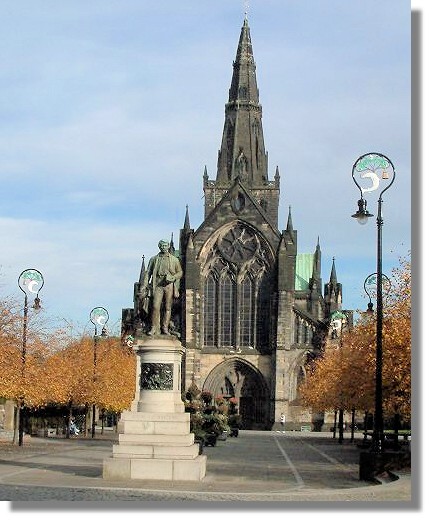
Glasgow Cathedral and Statue of David Livingston



